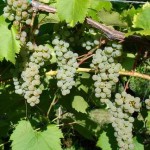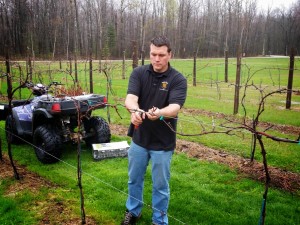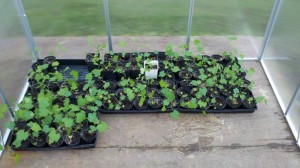Frontenac Blanc’s Promising Future

Frontenac blanc, photo courtesy of Northeastern Vine Supply
Frontenac blanc, a mutation of Frontenac gris, is the latest member of the Frontenac grape family. Viticulture experts say the variety was first observed in Quebec during 2005 and that the mutation was probably taking place at several Canadian and Minnesota vineyards at roughly the same time.
The parent grape, Frontenac, was introduced by the University of Minnesota in 1996. This dark blue-fruited cultivar originated from a cross of Vitis riparia x Landot 4511. On its website, the University describes the arrival of the blanc variety as ‘an exciting new development for cold climate growers” because of Frontenac’s cold tolerance and disease resistance.
Working with UC Davis, the University of Minnesota ( U of M) is now studying about a dozen Frontenac blanc vines at its Horticultural Research Center, including two clones from Quebec. So far, there doesn’t seem to be much difference between the clones.
John Thull, Vineyard Manager at the U of M, described the vine’s grape clusters as large and loose, often three per shoot. He said the cane and cordon wood is very dense and hard and the vines are durable enough to hang even through frosts. Thull said Frontenac blanc generally ripens earlier than Frontenac, however the variety can be bitter if picked early. He said the grape is susceptible to powdery mildew and phylloxera although downy mildew is rare.
With different clones already in the public domain, Thull said this variety is not controlled or licensed by the University but is available through several nurseries.
Thull’s colleague, Katie Cook, the Enology Project Leader at the University of Minnesota, said the Frontenac blanc mutation continues to show up in a lot vineyards across North America. “It’s not that rare to see this happen. I’ve also seen Pinot blanc clusters on Pinot gris,” she said.
Frontenac blanc isn’t widely available yet and Cook suggested it could take a couple more years before more nurseries breed the grape successfully. ‘I think one of the issues with some of the nurseries is that some people think they have Frontenac blanc, but it’s turning out not to be Frontenac blanc.”
It may be early days for this new grape, but experts like Cook think Frontenac blanc has considerable promise.
‘It has better disease resistance and grows a lot better than La Crescent [another hybrid created by the University of Minnesota],” she said. ‘Some people are getting frustrated with it (La Crescent) up because it can be a bit of a pain to grow. LaCrescent takes a little more time and effort as a grower.”
‘For me the Frontenac family is one of the easiest grapevines to grow. I think all the growers really like it,” added Cook.
The variety makes a more classic white wine than Frontenac gris. ‘One of the issues with Frontenac gris is it tends to make an amber colored wine, you get some color leaching from the skins,” said Cook.
“If you want to make a true white wine there’s going to be no issue with “pinking” when you’re working with Frontenac blanc. However, I think Frontenac gris is a little more versatile if you want to make Rose from it as well,” she added.
Cook said the natural high acidity of the Frontenac grape family works in favor of its blanc variety too, allowing winemakers produce sweet or off-dry whites.
John Marshall, a MWP columnist and owner of Great River Vineyard & Nursery near Lake City, Minnesota has about 1 acre of Frontenac blanc. He purchased his Quebec clones in 2009. Like Cook, Marshall is very positive about this grape’s potential.
“I think the prospects for Frontenac blanc are excellent!” he said. ‘It seems to retain the excellent growth characteristics and solid reliability of the original red Frontenac and from what I have seen it produces a clean, crisp, California-style white wine in the Chardonnay or Sauvignon Blanc style,” he said.
“We badly need a reliable, neutral, California-type white and this may well be a solution to this need,” said Marshall.
“It is a vine, much in demand with wineries and winemakers and I sense it will become enormously popular in the years ahead as Frontenac blanc grapes become more available to winemakers,” he added.
As part of her Horticultural Center’s research, Cook has become one of a small but growing number of winemakers who has made wine out of Frontenac blanc. For several years the Center’s dozen vines have produced up to ten liters.
‘It tastes good,” she said. ‘I think the early picked Frontenac blanc is similar to maybe a Sauvignon Blanc where it has that grassy, herbaceous character. The late harvest gets tropical fruit flavors and works really well as a dessert wine or a late harvest style wine. I like it more in that style.”
The first commercial bottlings of Frontenac blanc were made last year by two wineries: Coyote Moon Vineyards in Clayton, New York and Tongue River Vineyard & Winery in Miles City, Montana.
‘We did a cool primary ferment in HDPE plastic drums, finishing in steel– no oak, no ML, in a German style. Sweetened to 3%,” said Bob Thaden from Tongue River. The result is a wine called Cold Front.
‘It is hugely different than Front gris in flavor,” added Thaden. ‘It’s much simpler – with almost no tropical tones like Front gris – much more in the style of Riesling.”
Thaden is engaged in efforts to get the new grape onto the TTBs official list of approved grape variety names. Until it is on that list, the grape’s name cannot legally appear on a wine label, severely hampering marketing. Thaden has been reaching out for support from Frontenac blanc growers in states including Minnesota and Wisconsin.
One of the first vineyards to grow the grape in Wisconsin was Holy Grail Vineyard. Viticulturist, Matt Skaletski added Frontenac blanc to his plantings of Frontenac and Frontenac gris in 2011. “I’m kind of a grape collector,” said Skaletski.

John Marshall of Great River Vineyard and Nursery was one of the first growers to plant Frontenac Blanc.
“I drove 600 miles to buy them off John Marshal the very first year they were available,” he added. “The vines were tissue cultured and very delicate. I thought that I had lost over 60% of them, but the following year they really made a comeback and now I am almost at my original 100 I bought,” said the viticulturist.
Skaletski said he’s had lots of inquiries from other vineyards and wineries about his Frontenac blanc grapes but only knows of one other vineyard in his area of Wisconsin that grows it.
At Flying Otter Winery in Michigan, Bob Utter planted Frontenac blanc in 2010 and now has about 1 acre of vines. Winery owner Utter said the variety has been very vigorous on his site and while it is too early to come to any definitive conclusions about disease issues. “After this past harsh winter it appears to be very hardy, as expected,” Utter said.
Last fall was Flying Otter’s first harvest of Frontenac blanc grapes and Utter made a small batch of wine. “It was nice, but it is too soon to draw any conclusions on wine characteristics or quality,” he said.
However, other grape enthusiasts and experts are confident that Frontenac blanc has a bright future.
(Publisher’s note: The University of Minnesota, does not capitalize the ‘b” in ‘blanc” but Coyote Moon does. Midwest Wine Press would like to propose that the second word in all grape names be capitalized!)





This is an exciting development! Although I admire and enjoy the “fruit salad” aroma/flavors of Frontenac Gris wines, it will be great to be able to make a more neutral, food-friendly wine. I’m anxious to try some commercial examples.